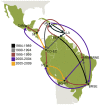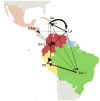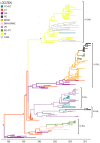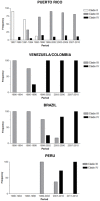Spatiotemporal dynamics of DENV-2 Asian-American genotype lineages in the Americas
- PMID: 24897118
- PMCID: PMC4045713
- DOI: 10.1371/journal.pone.0098519
Spatiotemporal dynamics of DENV-2 Asian-American genotype lineages in the Americas
Abstract
The Asian/American (AS/AM) genotype of dengue virus type 2 (DENV-2) has been evolving in the Americas over the last 30 years, leading to several waves of dengue epidemics and to the emergence of different viral lineages in the region. In this study, we investigate the spatiotemporal dissemination pattern of the DENV-2 lineages at a regional level. We applied phylogenetic and phylogeographic analytical methods to a comprehensive data set of 582 DENV-2 E gene sequences of the AS/AM genotype isolated from 29 different American countries over a period of 30 years (1983 to 2012). Our study reveals that genetic diversity of DENV-2 AS/AM genotype circulating in the Americas mainly resulted from one single founder event and can be organized in at least four major lineages (I to IV), which emerged in the Caribbean region at the early 1980s and then spread and die out with different dynamics. Lineages I and II dominate the epidemics in the Caribbean region during the 1980s and early 1990 s, lineage III becomes the prevalent DENV-2 one in the Caribbean and South America during the 1990 s, whereas lineage IV dominates the epidemics in South and Central America during the 2000s. Suriname and Guyana seem to represent important entry points for DENV-2 from the Lesser Antilles to South America, whereas Venezuela, Brazil and Nicaragua were pointed as the main secondary hubs of dissemination to other mainland countries. Our study also indicates that DENV-2 AS/AM genotype was disseminated within South America following two main routes. The first route hits Venezuela and the western side of the Andes, while the second route mainly hits Brazil and the eastern side of the Andes. The phenomenon of DENV-2 lineage replacement across successive epidemic outbreaks was a common characteristic in all American countries, although the timing of lineage replacements greatly vary across locations.
Conflict of interest statement
Figures







Similar articles
-
Evolutionary history and spatiotemporal dynamics of DENV-1 genotype V in the Americas.Infect Genet Evol. 2016 Nov;45:454-460. doi: 10.1016/j.meegid.2016.09.025. Epub 2016 Oct 3. Infect Genet Evol. 2016. PMID: 27713055
-
Dengue virus 2 American-Asian genotype identified during the 2006/2007 outbreak in Piauí, Brazil reveals a Caribbean route of introduction and dissemination of dengue virus in Brazil.PLoS One. 2014 Aug 15;9(8):e104516. doi: 10.1371/journal.pone.0104516. eCollection 2014. PLoS One. 2014. PMID: 25127366 Free PMC article.
-
Molecular epidemiology of American/Asian genotype DENV-2 in Peru.Infect Genet Evol. 2013 Aug;18:220-8. doi: 10.1016/j.meegid.2013.04.029. Epub 2013 May 3. Infect Genet Evol. 2013. PMID: 23648427
-
Origin, tempo, and mode of the spread of DENV-4 Genotype IIB across the state of São Paulo, Brazil during the 2012-2013 outbreak.Mem Inst Oswaldo Cruz. 2019 Jan 7;114:e180251. doi: 10.1590/0074-02760180251. Mem Inst Oswaldo Cruz. 2019. PMID: 30624458 Free PMC article. Review.
-
Recent Dengue Infection in Bangladesh: A Seasonal Endemic Progressing to Year-long Serious Health Concern.Euroasian J Hepatogastroenterol. 2023 Jul-Dec;13(2):145-151. doi: 10.5005/jp-journals-10018-1408. Euroasian J Hepatogastroenterol. 2023. PMID: 38222961 Free PMC article. Review.
Cited by
-
Re-introduction of dengue virus serotype 2 in the state of Rio de Janeiro after almost a decade of epidemiological silence.PLoS One. 2019 Dec 11;14(12):e0225879. doi: 10.1371/journal.pone.0225879. eCollection 2019. PLoS One. 2019. PMID: 31825989 Free PMC article.
-
Evolution of Subgenomic RNA Shapes Dengue Virus Adaptation and Epidemiological Fitness.iScience. 2019 Jun 28;16:94-105. doi: 10.1016/j.isci.2019.05.019. Epub 2019 May 16. iScience. 2019. PMID: 31154208 Free PMC article.
-
Revisiting Key Entry Routes of Human Epidemic Arboviruses into the Mainland Americas through Large-Scale Phylogenomics.Int J Genomics. 2018 Oct 8;2018:6941735. doi: 10.1155/2018/6941735. eCollection 2018. Int J Genomics. 2018. PMID: 30402454 Free PMC article.
-
Circulation of genotypes of dengue virus serotype 2 in Guangzhou over a period of 20 years.Virol J. 2022 Mar 18;19(1):47. doi: 10.1186/s12985-022-01773-7. Virol J. 2022. PMID: 35303899 Free PMC article.
-
Entomo-Virological Surveillance and Genomic Insights into DENV-2 Genotype III Circulation in Rural Esmeraldas, Ecuador.Pathogens. 2025 May 28;14(6):541. doi: 10.3390/pathogens14060541. Pathogens. 2025. PMID: 40559549 Free PMC article.
References
-
- Thomas SJ, Strickman D, Vaughn DW (2003) Dengue epidemiology: virus epidemiology, ecology, and emergence. Adv Virus Res 61: 235–289. - PubMed
-
- Vasilakis N, Weaver SC (2008) The history and evolution of human dengue emergence. Adv Virus Res 72: 1–76. - PubMed
-
- Holmes EC, Twiddy SS (2003) The origin, emergence and evolutionary genetics of dengue virus. Infect Genet Evol 3: 19–28. - PubMed
-
- Rico-Hesse R, Harrison LM, Salas RA, Tovar D, Nisalak A, et al. (1997) Origins of dengue type 2 viruses associated with increased pathogenicity in the Americas. Virology 230: 244–251. - PubMed
Publication types
MeSH terms
LinkOut - more resources
Full Text Sources
Other Literature Sources
Medical
Research Materials

